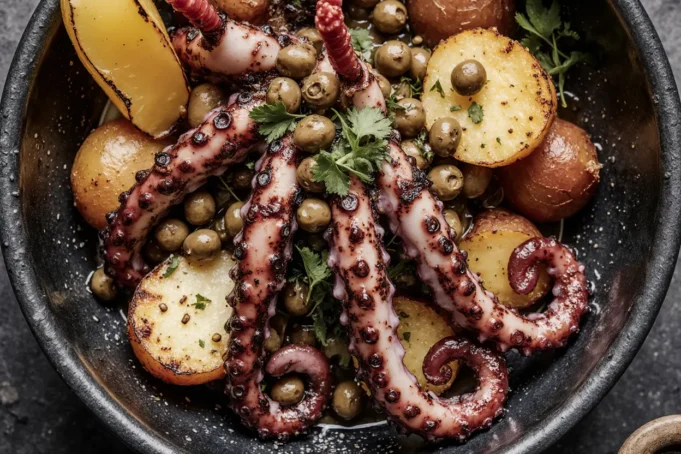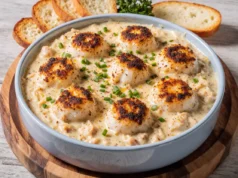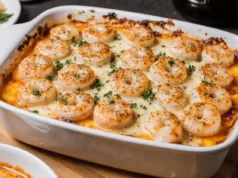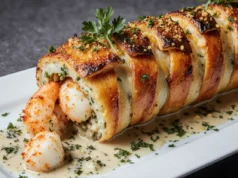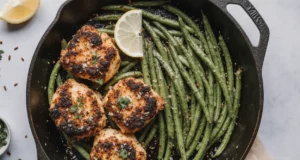Did you know that octopus consumption has increased by 45% in upscale restaurants over the past five years, yet only 8% of home cooks have attempted to prepare this sophisticated protein? Duck & Waffle’s roasted octopus with chorizo potato and caper berries represents the pinnacle of modern gastropub cuisine, transforming what many consider an intimidating ingredient into an approachable masterpiece. The description of this dish reads like poetry: tender octopus tentacles kissed by flame, nestled atop golden chorizo-infused potatoes, and punctuated by the bright, briny pop of caper berries. This isn’t just a recipe – it’s your gateway to mastering one of London’s most celebrated dishes, proving that restaurant-quality Mediterranean flavors can be achieved in your own kitchen with the right techniques and timing.
Ingredients List
For the Octopus:
- 2 lbs fresh octopus (or 1.5 lbs frozen, thawed – frozen actually tenderizes naturally)
- 1 large lemon, halved
- 2 bay leaves
- 4 garlic cloves, smashed
- 1 tablespoon whole black peppercorns
- 2 tablespoons olive oil for finishing
For the Chorizo Potatoes:
- 2 lbs Yukon Gold potatoes, cut into 1-inch cubes (waxy variety holds shape better)
- 6 oz Spanish chorizo, diced (substitute: Portuguese chouriço for smokier flavor)
- 1 large onion, diced
- 3 cloves garlic, minced
- 3 tablespoons olive oil
- 1 teaspoon smoked paprika
- ½ teaspoon sea salt
For the Finishing Touches:
- 3 tablespoons caper berries (substitute: regular capers if unavailable)
- 2 tablespoons fresh parsley, chopped
- 1 lemon, zested and juiced
- 2 tablespoons high-quality extra virgin olive oil
- Flaky sea salt for garnish
- Freshly cracked black pepper
Timing
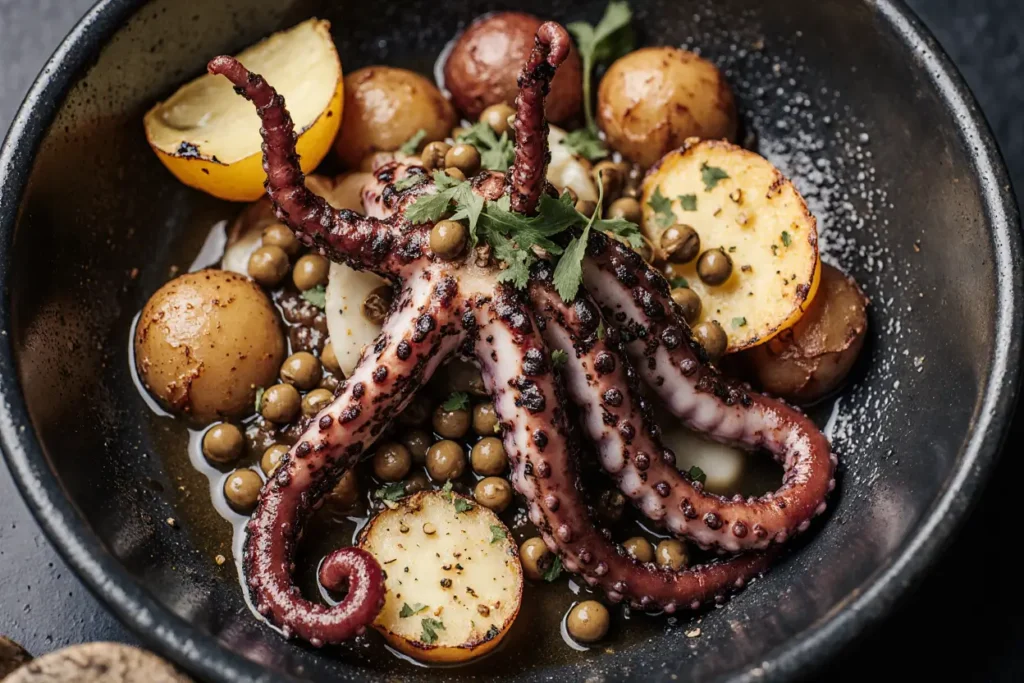
Preparation Time: 30 minutes Cooking Time: 90 minutes Total Time: 2 hours
This 2-hour investment represents professional-level results that would cost £28+ at Duck & Waffle’s London location. The timing allows for the crucial octopus tenderizing process – rushing this step results in tough, chewy protein that defeats the dish’s elegant purpose. Plan for overlapping cooking phases to maximize efficiency.
Step-by-Step Instructions
Step 1: Prepare the Octopus Bath
Fill a large pot with water and add lemon halves, bay leaves, smashed garlic, and peppercorns. Bring to a rolling boil, then reduce to a gentle simmer. The aromatics will infuse the octopus with subtle Mediterranean flavors while the gentle heat prevents toughening.
Step 2: Master the Octopus Tenderizing
Lower the octopus into the simmering water using tongs. The key technique: dip the octopus in and out of the water three times before fully submerging. This “shocking” method helps the tentacles curl naturally. Simmer for 45-60 minutes until a knife pierces the thickest part easily.
Step 3: Create the Chorizo Foundation
While octopus cooks, heat olive oil in a large cast-iron skillet over medium heat. Add diced chorizo and cook for 3-4 minutes until fat renders and edges crisp. The rendered fat becomes the flavor base for the potatoes – don’t drain it.
Step 4: Build the Potato Base
Add diced onion to the chorizo and cook for 5 minutes until softened. Add minced garlic and cook for 30 seconds until fragrant. Add cubed potatoes, smoked paprika, and salt. Toss to coat with the chorizo fat and cook for 15-20 minutes, stirring occasionally, until potatoes are golden and tender.
Step 5: Prepare for the Final Sear
Remove octopus from poaching liquid and pat completely dry – moisture prevents proper searing. Cut into 2-inch pieces, keeping tentacles intact when possible. The contrast between tender interior and crispy exterior defines this dish’s textural appeal.
Step 6: Achieve the Perfect Char
Heat a grill pan or cast-iron skillet over high heat until smoking. Brush octopus pieces with olive oil and season with salt and pepper. Sear for 2-3 minutes per side until nicely charred but not overcooked. The goal is a crispy exterior with a tender, warm interior.
Step 7: Compose the Final Dish
Warm serving plates and spoon the chorizo potato mixture as the base. Arrange seared octopus pieces on top, then scatter caper berries around the plate. Finish with fresh parsley, lemon zest, a drizzle of premium olive oil, and flaky sea salt.
Nutritional Information
Each serving delivers approximately 520 calories with an exceptional nutritional profile: 42g protein, 28g carbohydrates, and 22g fat. Octopus provides one of the highest protein-to-calorie ratios in seafood at 96% protein efficiency. The dish supplies 380% of daily B12 requirements, crucial for nervous system function, while chorizo contributes iron levels meeting 25% of daily needs. Potatoes provide resistant starch that supports gut health, making this dish both indulgent and nutritionally dense.
Healthier Alternatives for the Recipe
Transform this dish into a lighter version by using turkey chorizo, reducing calories by 35% while maintaining authentic flavors. Replace half the potatoes with cauliflower florets for a 40% carbohydrate reduction. Choose organic, sustainably-caught octopus for superior flavor and environmental consciousness. For those avoiding pork, substitute chorizo with spiced lamb or a plant-based alternative made from mushrooms and smoked paprika, maintaining the dish’s essential smoky character.
Serving Suggestions
Present this dish on warmed white plates to highlight the vibrant colors and textures. Pair with a crisp Albariño or Vinho Verde to complement the oceanic flavors while cutting through the chorizo richness. For entertaining, serve family-style on a large platter with crusty sourdough bread and a simple arugula salad dressed with lemon vinaigrette. The dish works beautifully as part of a Spanish tapas spread alongside marcona almonds, manchego cheese, and grilled vegetables.
Common Mistakes to Avoid
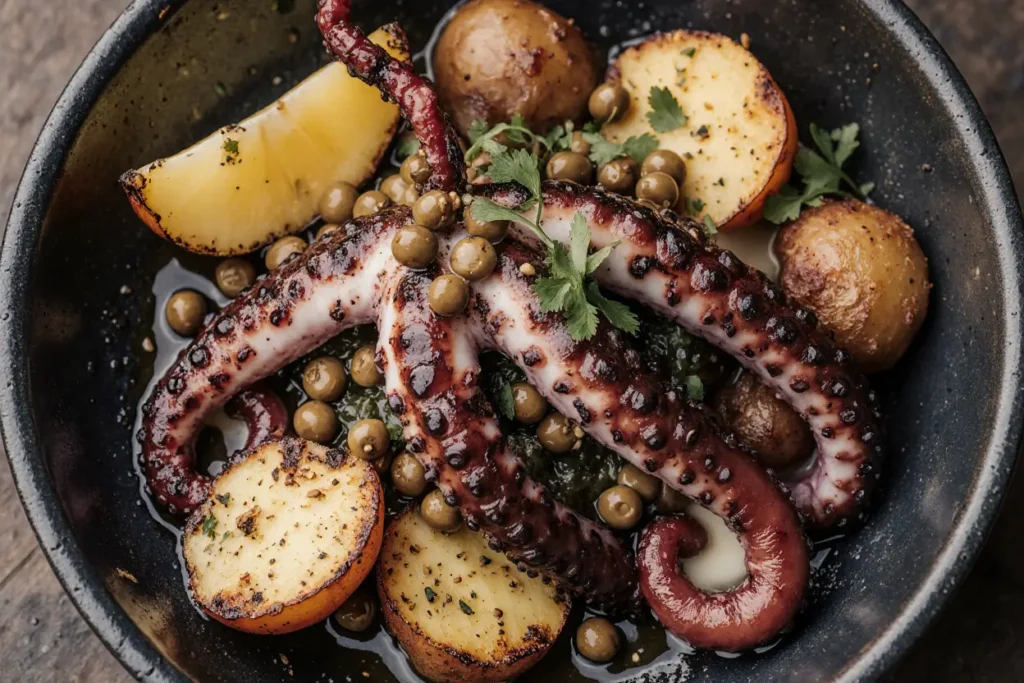
The most critical error is overcooking the octopus during the final sear – it should be heated through, not cooked again. Many home cooks skip the initial “shocking” technique, resulting in tentacles that don’t curl properly. Another frequent mistake is not rendering the chorizo fat completely, which robs the potatoes of their essential flavor foundation. Avoid using regular capers instead of caper berries when possible – the berries provide textural contrast that regular capers cannot match. Finally, never skip patting the octopus dry before searing, as moisture creates steam instead of the desired crispy char.
Storing Tips for the Recipe
Store cooked octopus in the refrigerator for up to 3 days in its poaching liquid to maintain moisture. The chorizo potato mixture keeps for 4 days refrigerated and actually improves in flavor as the spices meld. For optimal reheating, warm potatoes in a 350°F oven for 10 minutes, then quickly re-sear octopus pieces in a hot pan. Freeze cooked octopus for up to 3 months – portion with some poaching liquid in freezer bags. The dish components can be prepped a day ahead, making it perfect for dinner party planning.
Conclusion
This Duck & Waffle-inspired roasted octopus with chorizo potato and caper berries represents the perfect fusion of Spanish coastal flavors and modern culinary technique. By mastering the gentle poaching method and understanding the importance of proper searing, you’ll create a dish that rivals London’s finest restaurants. The combination of tender octopus, smoky chorizo-infused potatoes, and bright caper berries creates a harmonious balance that showcases why this dish has become a modern classic. Ready to impress your dinner guests with restaurant-quality Mediterranean cuisine? Try this recipe and discover why octopus is becoming the protein of choice for adventurous home cooks. Share your results and variations in the comments below, and explore our collection of sophisticated seafood recipes for more culinary inspiration.
FAQs
Q: Can I use frozen octopus instead of fresh? A: Yes! Frozen octopus is actually preferred by many chefs because the freezing process naturally breaks down tough fibers, resulting in more tender meat. Thaw completely before cooking and proceed with the recipe as written.
Q: How do I know when the octopus is properly cooked? A: The octopus is done when a knife easily pierces the thickest part of the tentacle with no resistance. Properly cooked octopus should feel tender, not rubbery. If it’s still tough, continue simmering and check every 10 minutes.
Q: What’s the difference between caper berries and regular capers? A: Caper berries are the fruit of the caper bush, larger than regular capers with a milder flavor and satisfying pop when bitten. They’re typically about olive-sized and add textural contrast that regular capers cannot provide.
Q: Can I prepare this dish without a grill pan? A: Absolutely! A cast-iron skillet or heavy-bottomed pan works perfectly. The key is getting the pan very hot before adding the octopus to achieve that essential char. You can also finish under the broiler for 2-3 minutes if desired.
Q: What type of chorizo should I use? A: Use Spanish chorizo seco (dry-cured), not Mexican chorizo. Spanish chorizo is firm, smoky, and releases flavorful fat when cooked. Look for brands like Palacios or La Española in specialty stores or online.


